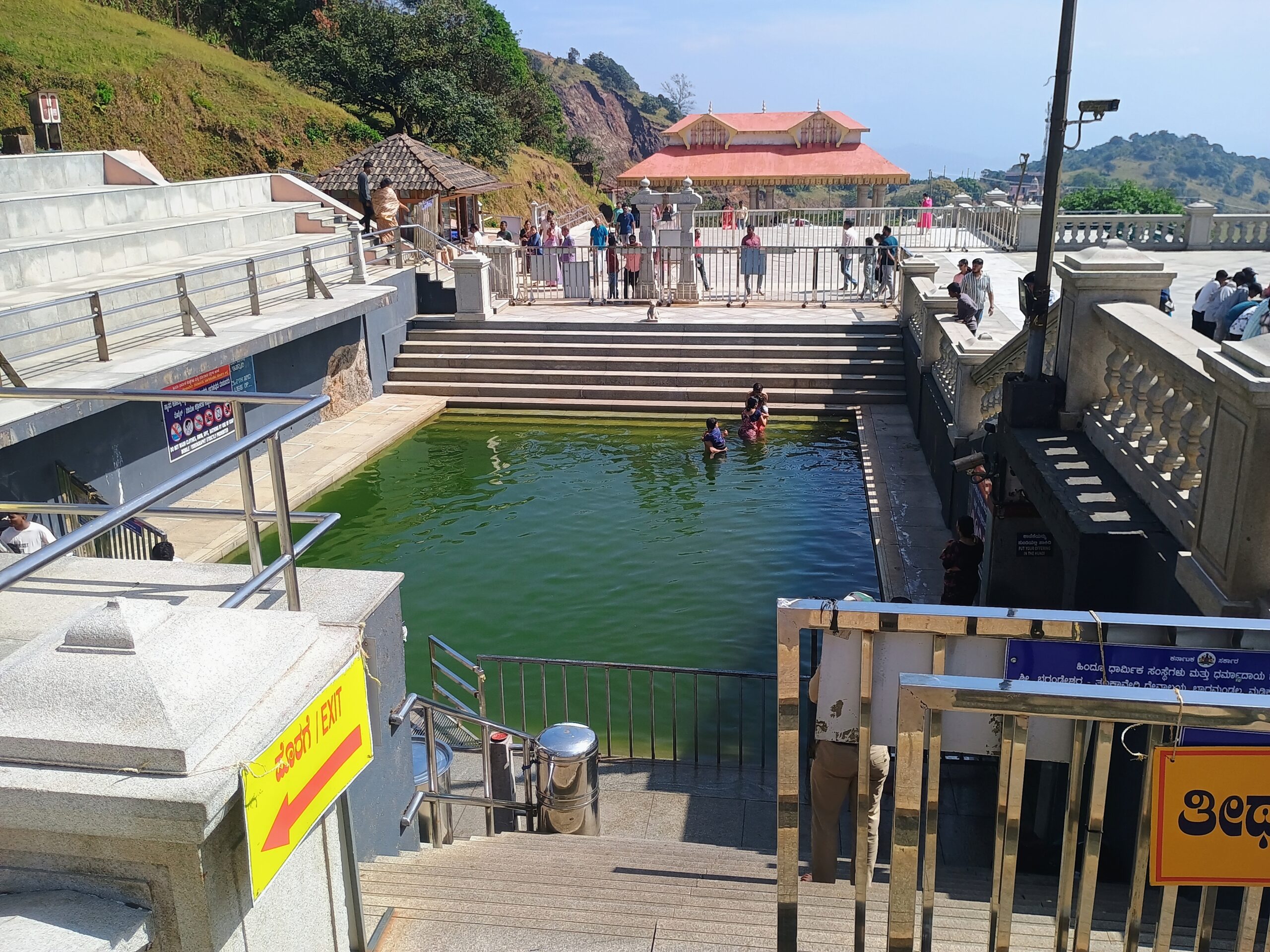During my recent visit last month, I was left pondering, and perplexed. 
Flowing across these hills in all her beauty, from her radiant source high in the western ranges of this tiny land, leaving stories at every twist and turn as she flows out of Kodagu, is the sacred river Kaveri. Every Kodava tries to visit the source of the river, if possible, annually. They go in October, at the time when the spring waters bubble up from the source, when they walk up the hill from Bhagamandala or, at least on the important occasions of life. This is where they come they come to immerse the ashes of their dead. Each home keeps Kaveri teertha, used in the very simple rituals they follow, and when a kodava dies, the sacred water is trickled into the mouth.
— Kaveri Ponnapa, The Vanishing Kodavas, 2013.
What Ponnapa so eloquently mentions in her book, sums up the devotion and importance of The River Goddess to the Kodavas.
In the years gone by, I have noticed several changes that have been made at this sacred place – many of which do not add grace to the sanctity of the location. Before the tourism boom in Kodagu, the natives of Kodagu and devotees from other places were the only ones to be seen in Tala Kaveri and Bhagamandala. Unfortunately this most sacred spot has now been reduced to a tourist destination. Plastic wrappers and bottles on the sides of the road from Bhagamandala to Tala Kaveri, desecrate the journey with unorganised restaurants and shops littering the roadside. Surprisingly there are shops even selling “Coorg Wine”. This is a rather strange and ungainly sight. Does it not make sense to keep the 7 km stretch of road free of and shops and establishments, so that devotees mind is focused on the final destination.
Let me narrate an interesting incident near the temple gate. The Sri Thalacauvery Bhagamandala Grama Panchayat is quick in collecting Rs 50 parking fee. Printed on the parking ticket is written -“SMOKING & ALCHOHOL ARE PROHIBITIED”, “PLASTIC FREE ZONE”. The rather aggressive ticket collector is oblivious to checking whether anyone is carrying alcohol or plastic with them. Where is the need of having shops, let alone selling “Coorg Wine”.
Interestingly, I also saw a statue next to a spice shop selling “wines”, which apparently represented the Goddess.


There are many such statues – For example there is one prominently at the entrance of Townhall at Madikeri.


There is also one more just before you cross the Kushalnagar bridge into Kodagu. Apparently this statue was installed in 2013.


Kaveramma is water, she has no representation of being in any figurative form or structure – especially human. Kodavas have always worshipped the source Tala Kaveri and her as free flowing water.
The phenomena of statues in and around Kodagu depicting Kaveramma is fairly recent – post 1956. This is not necessarily in keeping with the belief and cultural sanctity of the local native residents of Kodagu.
While Puranic legends like Kaveri Purana(Kaveri Mahatmyam) mentions the story of her Origin, the Kodavas were oblivious to the Sanskrit legend till the 19th Century. She was always worshipped as water. She is the one who was and is witness to their their prosperity, joy and sorrow of the agrarian community, since time immemorial.
The Kodavas came to know about the Puranic legend only after an official in British administration, a Kodava Dewan(Minister) – got the Sanskrit text translated to Kannada by Srinivasa Iyengar in 1864 at his personal expense.
I strongly feel – The Kodavas should not bother themselves with the Puranic story. They have have been worshipping Kaveri, even before they came to know about the puranic myth in 19th Century.
CURRENT SITUATION
During my visit in the last month, I noticed that the water is the tank has turned dark green. There can be no doubt that this is due to algae infestation. The purity of the water has been compromised, must be due to the heavy construction that has taken place during the last few decades. The Ramanagaram Granite which was used to redo the tank, has not helped. No purification system has been installed.


Taking ritual bath in such algae infested water also posses health risks.
The Algal bloom can be controlled. It is not as if the Temple Administration & Tourist Department are short of funds. A couple decades ago, only devotees from Coorg, the Old Mysore region and Tamil Nadu used to visit, now there is a daily footfall of tourists, many of whom do buy Archane/Archana(Worship/Devotion/Honor) tickets and offer donations into the Hundi. With these number of people visiting the place, surely temple income would have increased. Where is the “Honor”, I wonder.
There is an urgent need for accountability, checks and balances, and this applies to other sacred shrines like Bhagamadala & Igguthappa.


